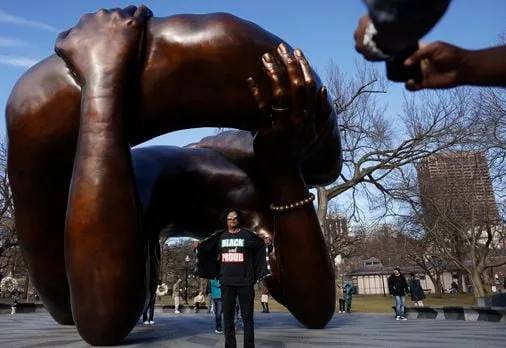
As Boston embarks on a massive undertaking to examine possible reparations for Black residents, a new report detailing the lasting legacy of slavery and systemic racism in the city offers solutions to redress the financial and emotional harms such discrimination has inflicted.
The report from Embrace Boston, titled “Harm Report: Connecting the Past to the Present State of Black Boston” and slated to be released Tuesday, could provide a potential road map to Boston’s reparations task force, which recently selected two research groups to analyze slavery’s impact on the city.
“This report hopefully puts blame not on people, but instead on processes,” said Imari Paris Jeffries, executive director of Embrace Boston, the organization that spearheaded the monument on Boston Common. “If we’ve created these processes, we can uncreate them.”
The suggested solutions are myriad and extend beyond cash payments. They include restitution for people harmed by marijuana-related arrests, spending more money on low-income schools, increasing more reliable transit options in Black neighborhoods, and expanding affordable housing.
And while it aims to make the case for local reparations, the report stops short of deciding which Bostonians would qualify. Paris Jeffries said this is intentional, so that the community can set its own parameters.
“Our study is more of a literature review and education framing for people,” Paris Jeffries said. “Reparations for who is where it’s going to get sticky.”
Despite its reputation as an abolitionist beacon, Boston planted some of the nation’s first seeds for racial inequality, the report says. Massachusetts was the first colony to legalize slavery, and built its wealth on the labor of enslaved people. By the late 1600s, more than half of the ships in Boston Harbor were involved in the West Indian slave trade, according to the report.
To highlight slavery’s legacy in Boston, the report targets seven “injury areas” where the impact of racism has lingered: culture and symbols, housing, transportation and infrastructure, education, criminal legal systems, health, and income and wealth. (Embrace Boston decided not to focus on environmental harm in this report because of its collaboration on another report that touches on the issue, Paris Jeffries said.)
The report calls attention to performance gaps in Boston Public Schools, where 75 percent of Black students graduated from four-year schools in 2020, compared with 84 percent of their white peers. That translated into racial income disparities among Bostonians; if the district closed the graduation gap, and 128 more Black students graduated that year, Embrace Boston estimates that it would have made up for $1 million in lost income for Black Bostonians currently without BPS diplomas, or $4 million if they had earned a bachelor’s degree.
The report also touches on disinvestments in public transit, such as the elevated Washington Street rail in the late ‘80s, and how its replacement with the Silver Line created an unreliable transit option for Roxbury residents traveling to and from downtown.
“In these efforts to revamp public transit, the city ultimately increased access to Boston’s suburbs, while effectively cutting off Roxbury and similar neighborhoods from easy and efficient rail access,” the report says.
Additionally, the study lays out the redlining practices of the 20th century that locked Black Boston families out of homeownership’s wealth-building opportunities, and connects that to the present. The report pointed to a 2020 study that showed Boston was ranked third in the nation for gentrification between 2013 and 2017. The city has seen a steep decrease in Black residents since 2000, as Boston becomes more expensive to live in, and people look for cheaper living options outside city limits.
Greg Wilmot, president and CEO of the East Boston Neighborhood Health Center, said the report’s historical perspective can give leaders ideas for rethinking investment in Boston’s Black community.
“The history and the context of how we got here is really important to know where we go from here,” Wilmot said.
While giving a potential road map for addressing Boston’s inequities, the report also affirms the racism that Black Bostonians face in their everyday lives, said Sandra McCroom, president and CEO of Children’s Services of Roxbury.
“This validates that we aren’t just angry people of color,” McCroom said. “We aren’t making this stuff up. There is a root to it.”
To reverse the harm done over centuries, the report suggests looking beyond simply issuing one-time payments, and instead creating changes that have a lasting impact.
The suggestions include full implementation of a state law that funnels extra cash into low-income schools, expanding wraparound services to all BPS students, and replacing the high-stakes MCAS tests with alternate measures of student performance.
On the area’s inequalities in criminal justice, the group lifts up the recommendations made by the Boston Area Research Initiative to reform the Boston Police Department, as well as reparations for people harmed by marijuana-related arrests and the city’s use of the criminal records check system.
Embrace Boston also offers changes that are symbolic, such as renaming monuments and public spaces to honor people that contributed to dismantling systemic racism, while lifting up Black history in school curricula and investing in Boston’s Black arts scene. It also suggests that local officials focus on policies that expand affordable housing and homeownership to all Bostonians, while simultaneously eliminating transit deserts in disadvantaged communities and incentivizing options that don’t rely on cars.
On the health front, Wilmot said the report could give health care leaders “a jumping-off point on using available resources strategically … to really address those structural and systemic issues that are getting in the way of getting to a healthier Boston.”
For McCroom, the report’s challenges and solutions underscore the need for wraparound resources like those at Children’s Services of Roxbury, which tries to repair the harms facing Black Bostonians on all fronts by catching residents from the earliest age.
“You can’t separate health from education; you can’t separate any of these injury areas,” McCroom said.
The report also suggests reparations be addressed in the State House. Legislation that would create a statewide commission similar to Boston’s task force studying reparations remains in committee.
In all, Paris Jeffries hopes the research won’t shut people out, but instead serve as an invitation to address the inequities that harm Bostonians, regardless of background.
“We’re not trying to place blame on one group or another,” Paris Jeffries said. “We’re trying to say, ‘Racism has impacted all of us.’”
Tiana Woodard is a Report for America corps member covering Black neighborhoods. She can be reached at tiana.woodard@globe.com. Follow her @tianarochon.


